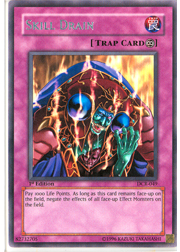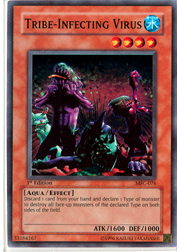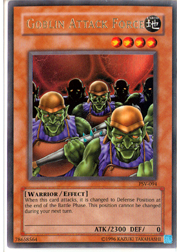The Yu-Gi-Oh! Trading Card Game has changed greatly since its initial release in the United States in 2002. Back then, almost all of the cards were quite simple to understand, with the exception of a few cards’ effects. The fact that most monsters in Legend of Blue-Eyes White Dragon and Metal Raiders were normal monster cards helped keep the game from getting too complicated, but there were a few troublesome cards out there that caused some confusion. For example, was the effect of Sword of Deep Seated an option, or was it a requirement to continuously place the equip spell on top of your deck if you kept sending it to the graveyard? The answer to that was simple for judges—there is nothing on the card that states the effect is optional.
However, the evolution of the game has resulted in more complicated card effects. Monsters with no effects have evolved into monsters that possess maintenance costs, trigger effects, and continuous effects. Then, there are cards that have simple-sounding effects, but the rulings behind them are hard to remember. An effect that states “remove this monster from the game until the end phase,” can be a complex ability that’s hard to understand within the context of a game.
 Today’s featured card, Skill Drain, falls in the category of “simple effects with complex rulings.” Duelists who refer to the official Yu-Gi-Oh! Trading Card Game website can see that the rulings on Skill Drain are nearly two full pages long! However, like Strike Ninja (last week’s card), Skill Drain is a complex card that may be confusing for beginners—but can work absolute wonders in the hands of an expert player.
Today’s featured card, Skill Drain, falls in the category of “simple effects with complex rulings.” Duelists who refer to the official Yu-Gi-Oh! Trading Card Game website can see that the rulings on Skill Drain are nearly two full pages long! However, like Strike Ninja (last week’s card), Skill Drain is a complex card that may be confusing for beginners—but can work absolute wonders in the hands of an expert player.
The Basic Breakdown
Skill Drain is a continuous trap card with no activation conditions that need to be met. This means that you may activate a face-down Skill Drain at any time outside of the damage step . . . unless something is prohibiting the activations of trap cards. Jinzo comes to mind. As an additional cost to activate this trap card, you must pay 1000 life points. However, after that activation requirement, Skill Drain will negate the effects of all face-up monsters on the field.
Sounds simple, right? It isn’t. While Skill Drain has the ability to negate some of the most devastating effects seen in tournament decks, such as those of Magician of Faith, Tribe-Infecting Virus, and sadly, Tsukuyomi, the rules of this continuous trap card can be very difficult to understand.
The Not-So-Basic Breakdown
The key thing to remember about Skill Drain is that it only negates the effect of monsters while they are on the field. This continuous trap may be able to negate effects, but it cannot stop an opponent from triggering the effects of his or her cards. This means that if a duelist triggers a monster’s effect, and upon resolution that monster is no longer face up on the field, that effect will resolve normally. This is because Skill Drain affects only the field and not any other part of the game zone, such as the graveyard or your hand. Perhaps an example would help to show you how Skill Drain works.
 Bill is dueling against Jae Kim, who is running a deck utilizing Skill Drain’s ability in more ways than one. Both players have three cards in hand. Bill has Tribe-Infecting Virus on the field in attack position, and Jae has D. D. Assailant face up on the field. Bill sends his Sinister Serpent from his hand to the graveyard to trigger the effect of his Tribe-Infecting Virus, but Jae chains Skill Drain to that. Jae’s trap card resolves first, and because his Skill Drain is face up and active when Tribe-Infecting Virus attempts to resolve, Bill’s Viral effect is negated.
Bill is dueling against Jae Kim, who is running a deck utilizing Skill Drain’s ability in more ways than one. Both players have three cards in hand. Bill has Tribe-Infecting Virus on the field in attack position, and Jae has D. D. Assailant face up on the field. Bill sends his Sinister Serpent from his hand to the graveyard to trigger the effect of his Tribe-Infecting Virus, but Jae chains Skill Drain to that. Jae’s trap card resolves first, and because his Skill Drain is face up and active when Tribe-Infecting Virus attempts to resolve, Bill’s Viral effect is negated.
What if Bill were to chain a removal ability, such as that of Mystical Space Typhoon, to the activation of Jae’s Skill Drain? Skill Drain would be removed from the field before it even goes active, Jae would still have to pay 1000 life points for the activation cost, and the effect of Tribe-Infecting Virus would resolve normally. It’s also important to note that the effect of Sinister Serpent will not be negated by Skill Drain. Here’s another example of how a player can evade the negation effect of Skill Drain.
Jae is holding off Bill’s attacks with Swords of Revealing Light. During his turn, Jae flip summons Magician of Faith, which targets the Pot of Greed in his graveyard. Bill looks at this move, and responds, “Um . . . I’ve got nothing.” Jae grins as he responds to Magician of Faith’s effect triggering with a Book of Moon from his hand, which flips Magician of Faith face-down before the little Spellcaster’s effect resolves. Once Magician of Faith’s effect resolves, it is face-down, and thus unaffected by Skill Drain. Jae returns Pot of Greed to his hand.
Of course, this same advantage of evading your own Skill Drain can be turned against you, if your opponent has the cards for it.
Bill sees three Warrior-type monsters on Jae’s side of the field. Bill summons Tribe-Infecting Virus from his hand, then calls priority and discards Sinister Serpent to declare the warrior type. Jae smiles, as he knows Bill has found a way of playing around Skill Drain. Bill chains to the Virus’s ignition effect with Ring of Destruction, which destroys his own monster. Once Tribe-Infecting Virus’s effect attempts to resolve, Skill Drain fails, since Bill’s monster is no longer face-up on the field. Jae loses his field of monsters.
 While Skill Drain can throw a painful wrench into an opponent’s plans, it also has the ability to turn monsters with negative effects into powerhouses. For example, while Skill Drain is active, you don’t have to pay life points to attack with Dark Elf. Better yet, after Goblin Attack Force attacks a monster, its position will not switch, because Skill Drain negates this effect. However, Skill Drain will not negate maintenance costs, so you still need to pay life points for cards such as Terrorking Archfiend, and you still have to remove spell counters for Armor Exe.
While Skill Drain can throw a painful wrench into an opponent’s plans, it also has the ability to turn monsters with negative effects into powerhouses. For example, while Skill Drain is active, you don’t have to pay life points to attack with Dark Elf. Better yet, after Goblin Attack Force attacks a monster, its position will not switch, because Skill Drain negates this effect. However, Skill Drain will not negate maintenance costs, so you still need to pay life points for cards such as Terrorking Archfiend, and you still have to remove spell counters for Armor Exe.
If you’re looking to get rid of Skill Drain before it starts to hurt your effect monsters, then look for methods of removing it from the field quickly and effectively. Emergency Provisions is, without a doubt, one of the best cards to utilize with Skill Drain. This not only removes Skill Drain even if Emergency Provisions is negated, but if it resolves without any issues, then you can gain back some of your life points in the process. Not a bad deal, right?
Counters to this Card
The most important thing you can do to deal with Skill Drain is to disrupt its activation and field presence as much as possible. It doesn’t matter how you do it. You can use standard spell or trap removal, such as Dust Tornado, or you can force your opponent to draw Skill Drain over and over again with Phoenix Wing Wind Blast. Giant Trunade is not only effective in disrupting a Skill Drain-based deck—it also clears the way for all of your monsters to attack that turn.
Remember that cards such as Chiron the Mage and Mobius the Frost Monarch will not be able to effectively remove Skill Drain, unless you have some method of removing that ignition effect monster from the field or flipping it face-down. Likewise, it’s going to be nearly impossible to use Breaker the Magical Warrior effectively, as spell counters cannot even be placed on a monster card while Skill Drain is active. Use your side deck and remove Breaker the Magical Warrior if you’re using it in your main deck.
Final Thoughts
Skill Drain works well against many annoying effect monsters that are commonly played in tournament decks, such as Breaker the Magical Warrior, Tribe-Infecting Virus, Airknight Parshath, Jinzo (if Skill Drain was activated before Jinzo was placed onto the field), and more. This trap card also helps in slowing down a few deck themes, or even shutting them down completely. Burner decks have enough enemies, and Skill Drain is another card on that long list of cards that hurt the Burner theme in tournament play. Skill Drain might be seen in successful competitive play in the Advanced format, whether in one week or a few months. Its ability to destroy entire themes and individual monsters makes this card a powerful concept for a deck.
As always, if you have any questions or concerns with this article or previous articles, feel free to e-mail me at Mrosenberg@metagame.com.